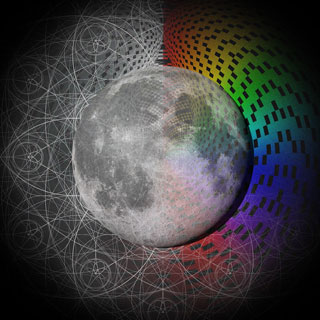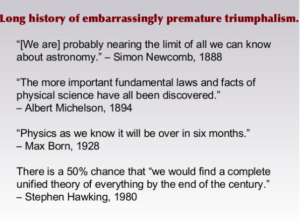
Frank Wilczek > The MIT Physics Annual 2009, “What is Space?“
[A parable] Suppose some species of deepwater fish, that never break the surface, evolved to become more intelligent, and started to do theoretical physics. At first they might formulate the laws of motion for the world they live in, and presumably would take for granted, namely the laws of motion for bodies moving through water. Now we humans know that the laws of motion for bodies moving through water are complicated, and they are not the most basic laws. The laws of motion for bodies moving through empty space are the most basic laws, and you can deduce the more complicated laws for bodies in water by applying those more basic laws to water molecules (deriving hydrodynamics) as well as the bodies moving through them. Eventually the fish-physicists would realize that they could get a nicer version of mechanics by assuming that they lived in a medium – call it water – [which] complicates the appearance of things. In this way, they’d realize that what they hitherto regarded as “nothingness,” their ever-present environment, is actually a material medium. And then they might be inspired to do experiments to try to make ripples in the medium, to find its atoms, and so forth.
Well, we’re like those fish. Human-physicists have discovered that we can get nicer, simpler accounts of how particles behave by assuming that we’re embedded in a medium, whose presence complicates the appearance of things.
[Even our own solidity is a “clumpy” (aggregate) flow through occupied spacetime, oblivious to other than (emergent) friction or viscosity between energy bundles at everyday scales.]
“I think it’s part of the nature of man to start with romance and build to a reality. In order to get the facts we have to be excited to go out and get them and there’s only one way to do that—through romance.” – Ray Bradbury, public symposium on “Mars and the Mind of Man” (November 12, 1971, Ramo Auditorium, Caltech)
Compare Ray Bradbury’s link between romance and reality with Richard Jenkyns’ note on the power of “romance and drama” in his Introduction to Lucretius’ [~50 BC] The Nature of Things (Penguin Classics 2007 | Kindle Edition | Translation & Notes A. E. Stallings 2007 | Introduction & Further Reading Richard Jenkyns 2007).
Here is the deepest reason why Lucretius’ philosophy must be poetry also. You cannot command a person into a feeling: it may be the best possible thing for Jack to fall in love with Jill, but we cannot instruct him to do so. Similarly, Lucretius cannot instruct us to love nature, the world and the everlasting atomic flux, to be rapt by the romance of a universal kinship; he can only achieve his end by writing a masterpiece so powerful in its poetry that we are persuaded to feel the romance and drama of his conception for ourselves. And therefore he embarked on the eccentric scheme of doing philosophy – real philosophy – in verse.
Re whether physics = math = reality
… while I find it comforting to think that reality is mathematics, I can’t actually get myself to believe it. It strikes me as presumptuous to think that humans have already discovered the language in which nature speaks, basically on the first try and right after we appeared on the surface of the planet. Who is to say there may not be a better way to understand our universe than mathematics, one that may take us a million years to figure out? Call it the principle of finite imagination: Just because we can’t currently think of a better explanation doesn’t mean there isn’t one. Just because we don’t yet know a better way to describe natural phenomena than mathematics doesn’t mean there isn’t one. – Hossenfelder, Sabine (2022). Existential Physics: A Scientist’s Guide to Life’s Biggest Questions . Penguin Publishing Group. Kindle Edition.

Philip Ball > The Atlantic > “The Universe Is Always Looking” by Philip Ball (October 20, 2018)
Einstein once expressed his exasperation at Bohr’s position on quantum weirdness to the young physicist Abraham Pais. “I recall,” Pais wrote, “that during one walk Einstein suddenly stopped, turned to me and asked whether I really believed that the moon exists only when I look at it.” With an understanding of decoherence, we have an answer to Einstein’s question. Yes, it is there when no one observes it—because the environment is already, and without cease, “measuring” it. All of the photons of sunlight that bounce off the moon are agents of decoherence, and are more than adequate to fix its position in space and give it a sharp outline. The universe is always looking.
[And note that we’re not just talking about “photons” of visible light, eh.]
Yeah, I’m finding it more and more interesting when physicists indicate their own puzzlement and wonder. Also, the blunders in the history of science.
We have evolved to be so used to how the “classical world” works that the actual physical mechanisms of the “quantum world” are simply beyond our ability to fully grasp. — Sebastian Deffner, Assistant Professor of Physics, University of Maryland, Baltimore County — How Fast Can Quantum Computers Get? (January 16, 2018)
(The quotes in this Wiki article on QM are interesting as well.)
Neil deGrasse Tyson 3-1-2012: “That within one linear centimeter of your lower colon there lives and works more bacteria (about 100 billion) than all humans who have ever been born. Yet many people continue to assert that it is we who are in charge of the world.” [Cf. “Can Microbes Encourage Altruism?“]
My quote (3-1-2017): “Nature has no square waves.” [Is this true? Has someone said this before?]
A lesson learned at Hughes: “Good ideas communicated poorly are indistinguishable from bad ideas.”
Upton Sinclair is also well remembered for the line: “It is difficult to get a man to understand something, when his salary depends upon his not understanding it.”
“Learn of the green world what can be thy place.” — Ezra Pound, Canto LXXXI
“Tell me a fact and I’ll learn. Tell me a truth and I’ll believe. But tell me a story and it will live in my heart forever.” — Native American Proverb
“We are stardust, we are golden, we are billion year old carbon” — Woodstock by Joni Mitchell as performed by Crosby, Stills, Nash & Young
“But in fact intellectual progress usually occurs through sheer abandonment of questions together with both of the alternatives they assume — an abandonment that results from their decreasing vitality and a change of urgent interest. We do not solve them: we get over them.” — John Dewey, The Influence of Darwin on Philosophy, p.19.
“The human understanding resembles not a dry light, but admits a tincture of the will and passions, which generate their own system accordingly; for man always believes more readily that which he prefers. He, therefore, rejects difficulties for want of patience in investigation; sobriety, because it limits his hope; the depths of nature, from superstition; the light of experiment, from arrogance and pride, lest his mind should appear to be occupied with common and varying objects; paradoxes, from a fear of the opinion of the vulgar; in short, his feelings imbue and corrupt his understanding in innumerable and sometimes imperceptible ways.” — NOVUM ORGANUM by Lord Bacon (Francis Bacon 1620) [Wiki: Novum Organum]
“Our main concentration will not be on how clever we are to have found the Law of Gravitation all out, but on how clever nature is to pay attention to it.” — Richard Feynman, The Character of Physical Law

Wikipedia:
Richard Feynman, one of the originators and early developers of the theory of quantum electrodynamics (QED), referred to the fine-structure constant in these terms:
There is a most profound and beautiful question associated with the observed coupling constant, e – the amplitude for a real electron to emit or absorb a real photon. It is a simple number that has been experimentally determined to be close to 0.08542455. (My physicist friends won’t recognize this number, because they like to remember it as the inverse of its square: about 137.03597 with about an uncertainty of about 2 in the last decimal place. It has been a mystery ever since it was discovered more than fifty years ago, and all good theoretical physicists put this number up on their wall and worry about it.) Immediately you would like to know where this number for a coupling comes from: is it related to pi or perhaps to the base of natural logarithms? Nobody knows. It’s one of the greatest damn mysteries of physics: a magic number that comes to us with no understanding by man. You might say the “hand of God” wrote that number, and “we don’t know how He pushed his pencil.” We know what kind of a dance to do experimentally to measure this number very accurately, but we don’t know what kind of dance to do on the computer to make this number come out, without putting it in secretly!
— Richard Feynman, Richard P. Feynman (1985). QED: The Strange Theory of Light and Matter. Princeton University Press. p. 129. ISBN 0-691-08388-6.
Some luminaries in science made really bogus predictions about atomic physics. Lord Kelvin has been quoted as saying of the “vortex nature of atoms” that “It is only a dream.” He required a physical model: “I never satisfy myself until I can make a mechanical model of a thing. If I can make a mechanical model I can understand it.” (See http://zapatopi.net/kelvin/quotes/) [1]
Ernest Rutherford has been quoted as saying: “If you can’t explain your physics to a barmaid, it is probably not very good physics.” (See http://www.sciencekids.co.nz/sciencefacts/scientists/ernestrutherford.html) But also that “… any one who expects a source of power from the transformation of these atoms is talking moonshine …” (See http://www.lhup.edu/~dsimanek/neverwrk.htm)
[2-18-2014] Well, then I noticed the series “Beyond the Wormhole” on TV. I mostly watched episodes in the evening when I was tired and / or distracted. Recently, after watching Episode 6 of Season 2 for the third time, I connected with the piece about physicist Yves Couder and his vibrating tray of silicone oil and spooky silicon droplet. Intriguing. Just what Lord Kelvin might want to satisfy his need for a mechanical model, eh.
Notes
[1] But contrary to the opening of this Phys.org article, Wiki indicates that Lord Kelvin did not declare theoretical physics stalled in 1900.
The statement “There is nothing new to be discovered in physics now. All that remains is more and more precise measurement” has been widely misattributed to Kelvin since the 1980s, either without citation or stating that it was made in an address to the British Association for the Advancement of Science (1900). There is no evidence that Kelvin said this, and the quote is instead a paraphrase of Albert A. Michelson, who in 1894 stated: “… it seems probable that most of the grand underlying principles have been firmly established … An eminent physicist remarked that the future truths of physical science are to be looked for in the sixth place of decimals.” Similar statements were given earlier by others, such as Philipp von Jolly. The attribution to Kelvin giving an address in 1900 is presumably a confusion with his “Two clouds” speech, delivered to the Royal Institution in 1900 (see above), and which on the contrary pointed out areas that would subsequently see revolutions.
